Lenses and Pinholes: What Does “In Focus” Mean?
In introductory physics, the optics unit often teaches about virtual and real images, focal lengths, indexes of refraction, etc. Some questions that are sometimes glossed over in the rush to present the mathematical formulas and definitions are: What does it mean for an image to form at a particular location? What does it mean for an image to be in focus? What happens if it’s not? And why (if you’re near-sighted) do things look clearer if you look through a tiny hole (or squint)?
This article will hopefully answer these questions.
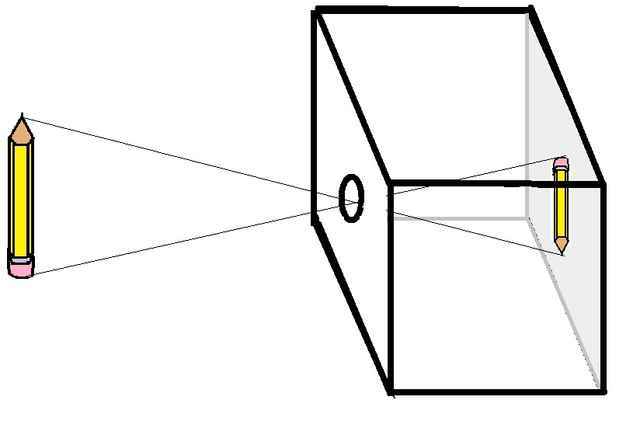
Figure 1: Schematic of a camera
Figure 1 shows a simple-minded idea of a camera (the old-fashioned, non-digital kind). You have a box. In the back of the box is photo-sensitive paper. In the front of the box, you have a hole to let light in. Light from an object (a pencil in the picture) goes through the hole and falls on the photo-sensitive paper, making a permanent image.
So the first question is: Why do you need a lens over the hole? The simple answer is: to make sure that the image is in focus. But that just raises the question: what does it mean to be in focus or not?

Figure 2: Image out of focus
In the second figure, I’ve done some ray tracing to show how light from the object travels to get to the image. I’ve concentrated on light from the point of the pencil. As you can see, light from the tip goes in all directions. A ray of light from the point entering the camera at the top of the hole will arrive at the paper at a slightly different location than light entering through the bottom of the hole. So instead of the image of the pencil point appearing at a specific spot on the paper, it’s smeared over a wide area. That’s what it means to be “out of focus”: the light from a single point on the object does not show up at a single point on the paper.
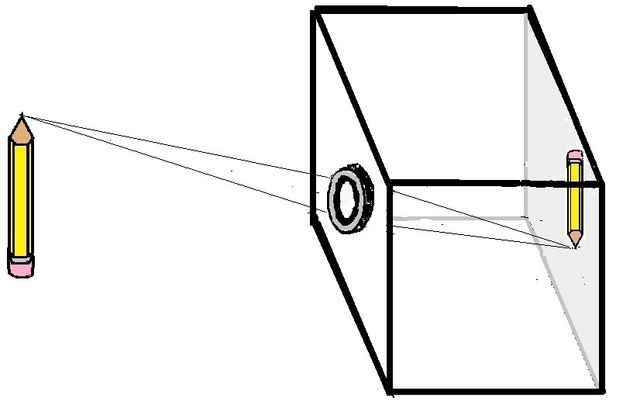
Figure 3: Using a lens
That is where the lens comes in. Because the lens is made of something with a higher index of refraction, light passing through the lens is bent. To get the image in focus at the back of the camera, the lens must bend light from the top of the hole downward and must bend light from the bottom of the hole upward, so that they meet at a single point on the paper. This is only possible for a particular combination of lens + distance to the object + distance from the lens to the back of the camera (as given by the thin lens equation: 1/f = 1/o + 1/i, where f is the focal length of the lens, i is the distance of the image from the lens–which is the distance from the front of the camera to the back, and o is the distance of the object from the front of the camera).

Figure 4: Using a pinhole
Going back to our simple-minded idea of a camera as a box with a hole in it, we can see why, if the hole is very tiny, a crisp, in-focus image is possible without a lens. If the hole is very tiny, then there is only one place on the paper where light from the pencil point can fall. There is only one point where the light from the eraser will fall. So the image of the pencil is not smeared out over a region–it appears at a precise location on the paper. So the image is in focus, regardless of the distance from the object to the camera.
It seems like a superior way to do cameras because there is no need for focusing. The drawback to a pinhole is that only a tiny amount of light gets through to form the image. So the advantage to using lenses is really that it increases the amount of light that gets through.

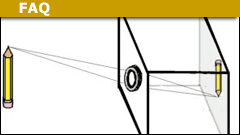


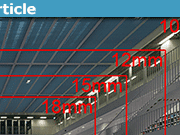
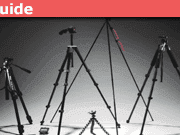

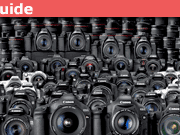
A pinhole does not have this problem.True. It masks the problem with problems of its own; the image from a pinhole is blurred for a start. It is a really trivial matter to make a lens with an aperture of, say f22 which will produce a sharper image than the equivalent pinhole and in which the Chromatic Aberration is hardly detectable. So in what respect would a pinhole be 'better'? In this game of Top Trumps, the only parameter for which the pinhole scores higher is on Production Cost.
The problem with a pinhole is basically that it doesn't let in enough light. Taking the Sun as the brightest subject for for observation, a pinhole camera is inadequate, even for that, if you want any serious resolution for sunspots etc.
a powerful lense.How "powerful" are you suggesting and how would a pinhole achieve the same result.
Good(ish) :smile:. The image will have no more detail than the diameter of the pinhole. That is probably not as good as a 20MPx camera sensor can record. But, projected on a big screen, the perceived sharpness can be good. (Darkened room needed, of course)Different colors within the image refract at different angles at the lens boundary. Thus different colors will have a different focal lengths for a glass lense. A pinhole does not have this problem. Pinholes never give rainbows unlike a powerful lense.
Even pinhole cameras can give good focus.Good(ish) :smile:. The image will have no more detail than the diameter of the pinhole. That is probably not as good as a 20MPx camera sensor can record. But, projected on a big screen, the perceived sharpness can be good. (Darkened room needed, of course)
Why do you need a lens over the hole? The simple answer is: to make sure that the image is in focus.Even pinhole cameras can give good focus. The reason we use lense is lense can gather much more light thus giving bright sharper picture unlike a tiny hole.
After reading this , I understood what is exactly meant by " in focus".
Thank you, thanks a lot for posting this insight post.
I'm… not sure I know what that means, lol.http://dictionary.cambridge.org/dictionary/english/horses-for-courses extended by me (and others) to include things / systems etc.
It's horses for courses, as ever.I'm… not sure I know what that means, lol.
"It seems like a superior way to do cameras, because there is no need for focusing."
Reference https://www.physicsforums.com/insights/lenses-pinholes-focus-mean/
As a matter of fact, extreme depth of focus is not always an advantage. Limiting the depth of the sharp field is an important aspect of many photos for artistic reasons and also for emphasising and isolating detail. Binoculars can often allow you to see a bird behind a bush because the bird can be in sharp focus and the bush can be a blur. Also, of course, diffraction rears its ugly head with small apertures. If you want to image two closely adjacent stars, you will be needing a telescope objective of many (even hundreds of) cm diameter. It's horses for courses, as ever.
I like what you've done with figure 2. It shows that if you take 2 different rays from the same point, then they essentially help form two separate images of the same object at slightly different locations which may overlap each other. Taken to the extreme, this means that without a lens, there are an "infinite" number of overlapping images that wind up being a blurry mess. The smaller the aperture, the tighter the grouping of the images and the less blurred the overall image is.
For an introductory article, I think it would be good to include a small paragraph why we need the pinhole in the first place.
Great addition to our FAQs!